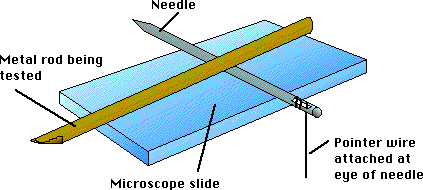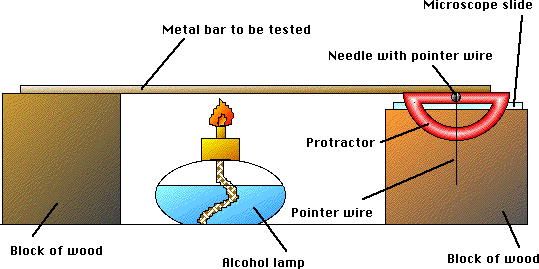Expansion/Contraction of Metals
Students' Page
Copyright 1999 by James
P. Riser
Background info:
In this activity you will be comparing expansion and contraction
rates for several types of metals. You will be working with fire
and need to take necessary precautions. It will be wise to remember
that the metal being heated will remain hot for a few minutes
after the flame is removed!
Goals - this activity was created to present you with the
opportunity to:
- Get acquainted with the concept of "rate"
- Compare several rates
- Collect your own data
- Design your own data chart
- Create graphs of your own data
- Formulate conclusions based upon your own experimental results
The specialized equipment needed is illustrated below:
 A large sewing needle needs to have a copper
wire pointer threaded through it and twisted around the needle
eye.
A large sewing needle needs to have a copper
wire pointer threaded through it and twisted around the needle
eye.
The needle rests between the glass microscope slide and the
metal bar being tested.
As the bar expands, the needle will roll like a wheel. This
causes the pointer to move.
Readings are taken from a watch and the protractor. You are
to record both time and degree readings.
A view of the complete apparatus:

Getting started:
- Locate the assortment of bars to be tested for expansion
and contraction rates. Notice that all of the bars are the same
length and the same diameter.
- Design a data chart to record the time interval (in seconds),
the material being tested (type of rod), and degree reading at
each time interval. Hint: You might want your time intervals
to be as short as 5 seconds.
- Make certain that the bars are all room temperature
before beginning the testing.
- Assemble the apparatus as shown above. Set the pointer so
that it points straight down at the beginning.
- On your data chart, be certain to record expansion
readings as positive numbers (+) and contraction
readings as negative numbers (-)
- To test contraction, merely remove the heat and continue
recording data until the pointer ceases to move.
- After testing all rods for both expansion and contraction,
graph the data on your chart. You might want to create
a separate graph for each rod type.
- Analyze your data and formulate conclusions as to which material
expands the fastest (not the most).
- Also, state which material contracts at the fastest rate.
- Define what is meant by the term "rate".
- Explain how rate applies to this lab activity.
- Turn in your complete write up including data charts,
graphs, and conclusions.
A large sewing needle needs to have a copper
wire pointer threaded through it and twisted around the needle
eye.